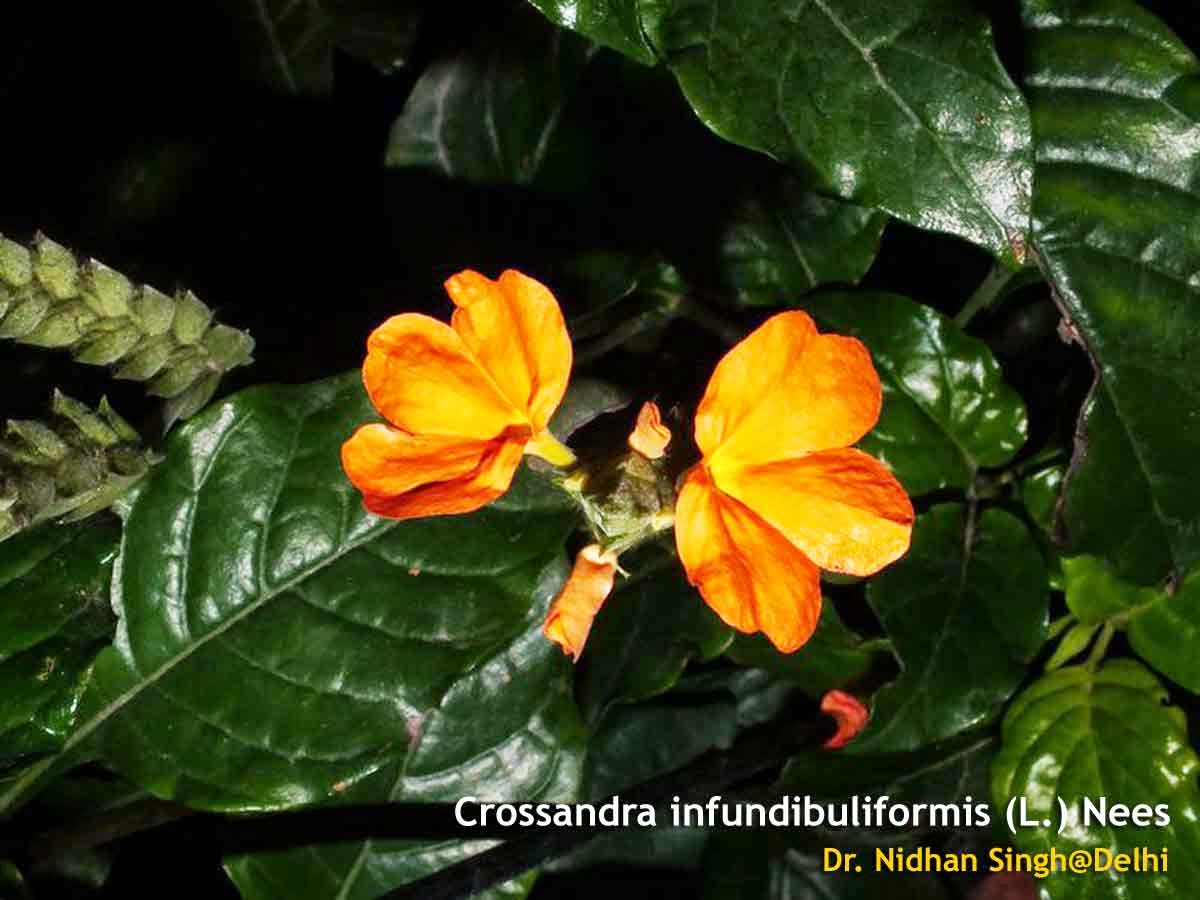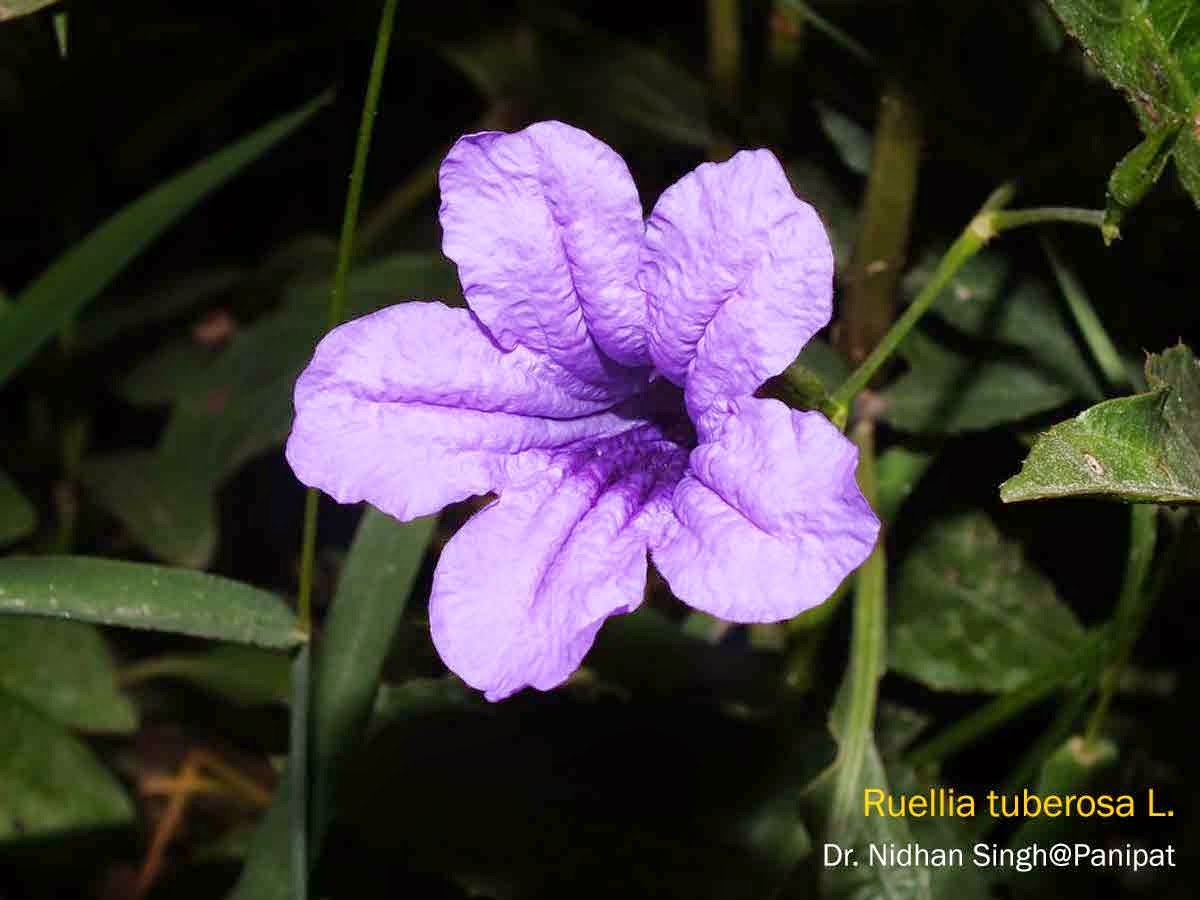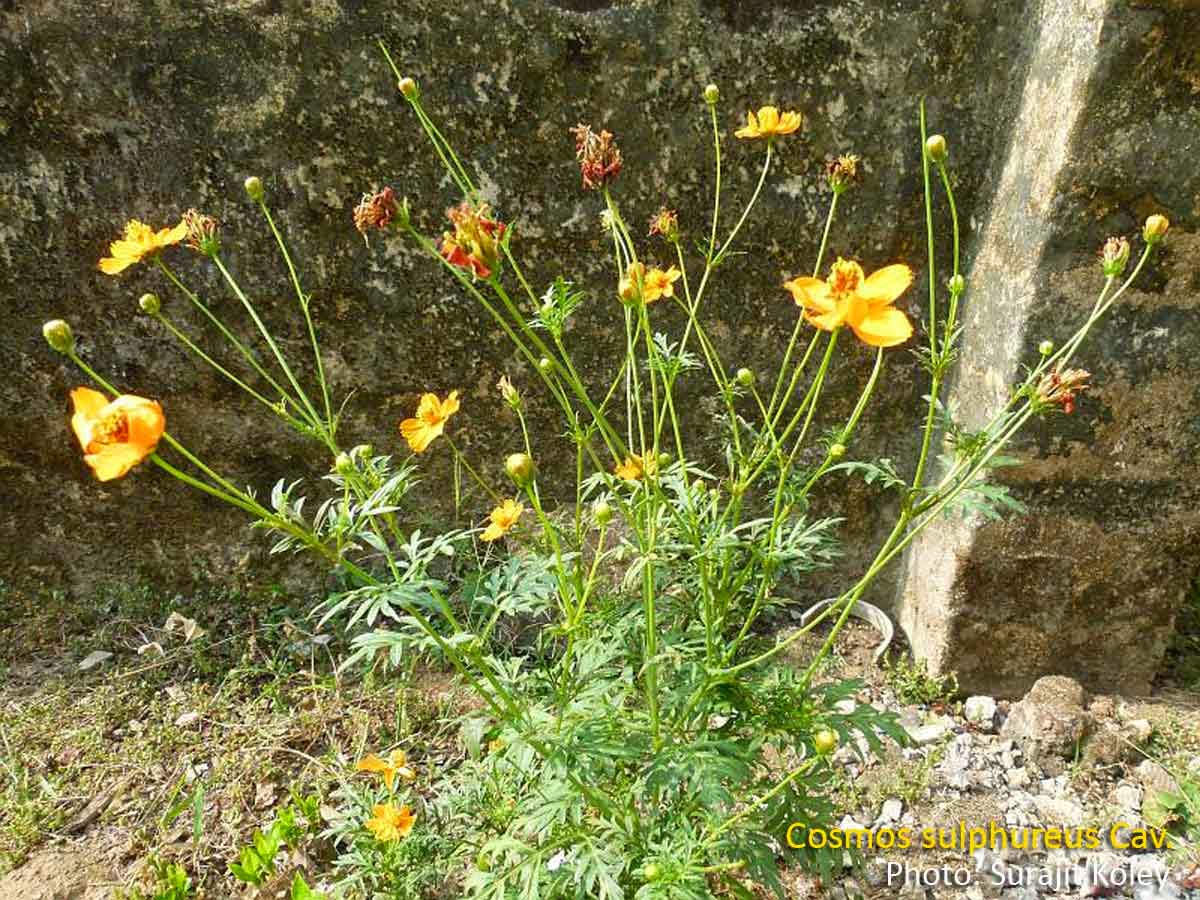
Gmelina arborea Roxb.
Family: Lamiaceae
- Common name: Gamhar
- Assamese: Gomari
- Bengali: গাম্ভারি Gambhari, গামার Gamar
- Chinese: 酸树
- Finnish: Intianjemane
- French: Gmélin arboré
- Gujarati: શેવન Shevan
- Hindi: गम्हड़ Gamhar, भद्रपर्णी Bhadraparni
- Kannada: ಶಿವನಿಮರ Shivanimara, ಕಾಶ್ಮೀರಿ ಮರ Kaashmiri Mara
- Konkani: Sirni
- Malayalam: Kumbil, കുമിഴ് Kumizh, കുമ്പിള് Kumpil
- Manipuri: ৱাঙ Wang
- Marathi: शिवण Sivan, थोरशिवणी Thorshivani
- Oriya: Thlanvawng
- Sanskrit: Madhumati, गम्भारी Gambhari, स्तूलत्वचा Stulatvacha
- Tamil: Kumalaamaram, குமுதை Kumutai, கூம்பல் Kumpal, பெருங்குமிழ் Peru-n-kumil
- Telugu: పెద్ద గుముడు టేకు Peddagumudutekku, పుల్లగుమ్మడి Pullagummadi, అడవి గుమ్మడి Adavigummadi
- Thai: ซ้อ
Description: Trees ca. 15 m tall; bark grayish brown; branchlets, petioles, and inflorescences densely yellow-brown tomentose. Branchlets slightly 4-angled when young, becoming terete, lenticellate, leaf scars prominent. Petiole terete, 3.5-10 cm; leaf blade broadly ovate, 8-19 X 4.5-15 cm, thickly papery, base broadly cuneate to subcordate, apex acuminate; veins 3-5 pairs, abaxially prominent. Inflorescences terminal, narrow thyrses; peduncle 15-30 cm. Calyx 3-5 mm, with several black discoid gland patches; teeth 5, sharply triangular. Corolla yellow, 3-4 cm, 2-lipped, sparsely glandular; lower lip 3-lobed, outside yellowish brown puberulent, inside glabrous; upper lip entire or slightly 2-cleft. Ovary glabrous, glandular. Stigma unequally 2-cleft. Drupes yellow when ripe and black when dry, ellipsoid to obovoid-ellipsoid.
Coomb teak, Candahar tree or Kashmeeri tree is a moderate sized, unarmed, deciduous tree which is a vital ingredient of the ”dasamula” (group of ten roots). The whole plant is medicinally very important. It promotes digestive power, improves memory, overcomes giddiness and is also used as an antidote for snake bite and scorpion sting. Roots are useful in hallucination, fever, dyspepsia, hyperdipsia, haemorrhoids, stomachalgia, heart diseases, nervous disorders, piles and burning sensation. Bark is used in fever and dyspepsia. Leaf paste is good for cephalagia and leaf juice is a good wash for foul ulcers and is also used in the treatment of gonorrhoea and cough. Flowers are recommended for leprosy, skin and blood diseases. The fruits are used for promoting the growth of hair and in anaemia, leprosy, ulcers, constipation, strangury, leucorrhoea, colpitis and lung disease. Wood is one of the best and most reliable timber of India. It is used for making furniture, planks, carriages, printing boxes, musical instruments, shafts, axles, picture frames, jute bobbins, calipers, ship buildings, artificial limbs and stethoscopes. [Medicinal Plants Kerala Ag Uni.]
Used in Ayurveda. Flowers used in blood diseases. Leaves demulcent, carminative, purgative, diuretic, antiinflammatory, used in gonorrhea, snakebite, scorpion sting, cough and ulcers; leaves decoction to cure gonorrhea and cough; applied in rheumatic affections, headache; leaves infusion carminative, given in indigestion. Fruits cooling, wound dressing, insecticide and astringent, for skin diseases, biliousness, fever and urticaria; ripe fruit juice with sugar and pomegranate fruit juice taken for dysentery. Bark decoction for stomach ailments; root paste of Abroma augustum with bark of Adhatoda zeylanica, Gmelina arborea and roots of Amaranthus spinosus applied on forehead in headache; inner bark powder used in scabies; stembark used as an anti-dote to poisoning, a paste applied for whitlow. Roots, leaf sap and flowers decoction, anodyne, diuretic, galactagogue, laxative, for loosening phlegm, an appetite stimulant, for the treatment of liver disorders. Roots bitter, tonic, stomachic, laxative and galactagogue, applied externally on wounds, gout and abscesses; root decoction given in indigestion, fevers and anasarca; extract of the root given as blood purifier. Veterinary medicine, bark boiled with water applied on tumors. Sacred plant, ceremonial sacrifice. [CRC World Dictionary of Medicinal and Poisonous Plants]
To rectify eyeSight during diabetes [Herbal Cures Traditional Approach]
Root: as blood purifier, Leaf: as carminative; Birhore: Leaf: in headache; Santal: in anasarca, asthma, bronchitis, cholera, colic pain, diarrhoea, dropsy, dyspepsia, epilepsy, fever, phthisis, rheumatism, smaIl pox, sore, spleen complaints, syphilis, throat swelling, urticaria, as antidote to snake bite and some other poisons; Munda: Bark: to cure wounds; Sora (Orissa): Root: in catarrh of bladder; Decoction of root: as tonic; Bark: in stomach disorder; Ethnic Communities of Araku Valley (Andhra Pradesh): Root: in malarial fever; Ethnic Communities of Godavari (Andhra Pradesh): Bark-paste: on bone fracture, Leaf: in cough, gonorrhoea; Ethnic Communities ofDehra Dun {Uttar Pradesh): Leaf-paste: on wounds; Atharvaveda: blood purifier; Charaka Samhita: useful in vomiting, dropsy and in burning sensation of the body; Sushruta Samhita: energiser like grape, can be used as substitute of sweet date palm; Bhavaprakasha: it is bitter, appetiser, brain tonic, energiser, digestive, subdues vata and kapha, removes dropsy, alleviates thirst, useful in colic pain, burning sensation of body, fever, urinary complaints, wastage; Rajanighantu: it is pungent, bitter, heavy (guru), thermogenic, removes oedema, phlegm, tridosha, burning sensation, fever, thirst, poisons; Dhanvantarinighantu: bitter, thermogenic, removes bleeding tendency, tridosha .• fatigue, burning sensation of body, fever, thirst; Kaiyaoevanighantu: it is sweet, bitter, thermogenic, heavy, appetiser, digestive, brain tonic, removes dropsy, giddiness, colic pain, toxins, burning sensation of body, fever, alleviates thirst; flowers sweet, cooling, bitter, astringent, beneficial for the diseases caused by pitta and kapha; fruits unctuous, heavy, cooling, astringent, brain tonic, cardiotonic, removes giddiness, acidity, urinary troubles, burning sensation of body, wounds, wastage and troubles caused by vata; Rajavallabham: fruits seizing, bitter, sweet, heavy, cooling, good for hair, brain, removes burning sensation of body and diseases caused by pitta; roots are too hot; Nighantu ratnakaram: it is pungent, bitter, hot, astringent, heavy, sweet, appetiser, digestive, brain tonic, cardiotonic, removes thirst, colic pain, oedema, phlegm, toxins, burning sensation of body, fever, impurities of blood, piles, giddiness; fruits aphrodisiac, heavy, increases semen, cooling, unctuous, increa~s intelligence, removes urinary troubles, impurities of blood, thirst, burning sensation of body, good for urticaria, consumption, wounds, leucorrhoea. Ayurveda: Root: Acrid, bitter, anthelmintic, galactogogue, laxative, stomachic, tonic, useful in burning sensation, dyspepsia, fever, haemorrhoids, hallucination, hyperdisia and stomachalgia; Bark: bitter, tonic, stomachic, useful in dyspepsia, fever; Leaf-paste: useful in cephalalgia, Leaf-extract: good wash for foul ulcer; Flower: acrid, astringent, bitter, refrigerant, sweet, useful in skin diseases including leprosy; Fruits: acrid, alterant, aphrodisiac, astringent, bitter, diuretic, refrigerant, sour, sweet, tonic, trichogenous, useful in anaemia, blood dysentery, constipation, leprosy, leucorrhoea, malnutrition of child and embryo, strangury and wounds. [Horticultural, Medicinal and Aromatic Plants]
Leaf—demulcent, bechic. Used for removing foetid discharges from ulcers. Root— stomachic, laxative, antibilious, demulcent, galactagogue. Bark—anticephalalgic. Root and bark—febrifuge. The Ayurvedic Pharmacopoeia of India recommends the use of the bark and stem in inflammatory diseases and oedema; the fruit in dysuria and haemorrhagic diseases. [Indian Medicinal Plants An Illustrated Dictionary]
Medicinal use: Ethanolic extract of bark and wood is hypoglycemic and antiviral. Bark is also used as bitter tonic and galactagogue. Juice of young leaves is used as demulcent, in gonorrhea and coughs. Flowers are used in leprosy and blood diseases. Fruit is diuretic, tonic, aphrodisiac, alterative and is used in anemia, leprosy and ulcer. Root and root bark are stomachic, laxative, anthelmintic and used in fever, piles and abdominal pains. Other uses; the wood is used as a source of paper-pulp, lumber, shade and ornament. Its wood resembles that of Teak and Is widely employed In carriage-building and ornamental cabinet work, in the manufacture of palanquins, shafts, axels, yokes, agricultural instruments, toys etc. The fruit is edible. Traditional use by the herbal healer of Bolipara: Local herbal healers use this for several treatment purposes as diarrhea, intestinal worm and sore. [Medicinal Plants of Chittagong]
The juice of the leaves of this tree is used to remove foetid discharges and worms from ulcers. A decoction of the roots and bark is given for fever and thirst and to increase the secretion of milk in women. [Medicinal Plants (Indigenous and Exotic) Used in Ceylon – Part-V]
Coomb teak, Candahar tree or Kashmeeri tree is a moderate sized, unarmed, deciduous tree which is a vital ingredient of the ”dasamula” (group of ten roots). The whole plant is medicinally very important. It promotes digestive power, improves memory, overcomes giddiness and is also used as an antidote for snake bite and scorpion sting. Roots are useful in hallucination, fever, dyspepsia, hyperdipsia, haemorrhoids, stomachalgia, heart diseases, nervous disorders, piles and burning sensation. Bark is used in fever and dyspepsia. Leaf paste is good for cephalagia and leaf juice is a good wash for foul ulcers and is also used in the treatment of gonorrhoea and cough. Flowers are recommended for leprosy, skin and blood diseases. The fruits are used for promoting the growth of hair and in anaemia, leprosy, ulcers, constipation, strangury, leucorrhoea, colpitis and lung disease. Wood is one of the best and most reliable timber of India. It is used for making furniture, planks, carriages, printing boxes, musical instruments, shafts, axles, picture frames, jute bobbins, calipers, ship buildings, artificial limbs and stethoscopes. [Medicinal Plants Kerala Ag Uni.]
Used in Ayurveda. Flowers used in blood diseases. Leaves demulcent, carminative, purgative, diuretic, antiinflammatory, used in gonorrhea, snakebite, scorpion sting, cough and ulcers; leaves decoction to cure gonorrhea and cough; applied in rheumatic affections, headache; leaves infusion carminative, given in indigestion. Fruits cooling, wound dressing, insecticide and astringent, for skin diseases, biliousness, fever and urticaria; ripe fruit juice with sugar and pomegranate fruit juice taken for dysentery. Bark decoction for stomach ailments; root paste of Abroma augustum with bark of Adhatoda zeylanica, Gmelina arborea and roots of Amaranthus spinosus applied on forehead in headache; inner bark powder used in scabies; stembark used as an anti-dote to poisoning, a paste applied for whitlow. Roots, leaf sap and flowers decoction, anodyne, diuretic, galactagogue, laxative, for loosening phlegm, an appetite stimulant, for the treatment of liver disorders. Roots bitter, tonic, stomachic, laxative and galactagogue, applied externally on wounds, gout and abscesses; root decoction given in indigestion, fevers and anasarca; extract of the root given as blood purifier. Veterinary medicine, bark boiled with water applied on tumors. Sacred plant, ceremonial sacrifice. [CRC World Dictionary of Medicinal and Poisonous Plants]
To rectify eyeSight during diabetes [Herbal Cures Traditional Approach]
Root: as blood purifier, Leaf: as carminative; Birhore: Leaf: in headache; Santal: in anasarca, asthma, bronchitis, cholera, colic pain, diarrhoea, dropsy, dyspepsia, epilepsy, fever, phthisis, rheumatism, smaIl pox, sore, spleen complaints, syphilis, throat swelling, urticaria, as antidote to snake bite and some other poisons; Munda: Bark: to cure wounds; Sora (Orissa): Root: in catarrh of bladder; Decoction of root: as tonic; Bark: in stomach disorder; Ethnic Communities of Araku Valley (Andhra Pradesh): Root: in malarial fever; Ethnic Communities of Godavari (Andhra Pradesh): Bark-paste: on bone fracture, Leaf: in cough, gonorrhoea; Ethnic Communities ofDehra Dun {Uttar Pradesh): Leaf-paste: on wounds; Atharvaveda: blood purifier; Charaka Samhita: useful in vomiting, dropsy and in burning sensation of the body; Sushruta Samhita: energiser like grape, can be used as substitute of sweet date palm; Bhavaprakasha: it is bitter, appetiser, brain tonic, energiser, digestive, subdues vata and kapha, removes dropsy, alleviates thirst, useful in colic pain, burning sensation of body, fever, urinary complaints, wastage; Rajanighantu: it is pungent, bitter, heavy (guru), thermogenic, removes oedema, phlegm, tridosha, burning sensation, fever, thirst, poisons; Dhanvantarinighantu: bitter, thermogenic, removes bleeding tendency, tridosha .• fatigue, burning sensation of body, fever, thirst; Kaiyaoevanighantu: it is sweet, bitter, thermogenic, heavy, appetiser, digestive, brain tonic, removes dropsy, giddiness, colic pain, toxins, burning sensation of body, fever, alleviates thirst; flowers sweet, cooling, bitter, astringent, beneficial for the diseases caused by pitta and kapha; fruits unctuous, heavy, cooling, astringent, brain tonic, cardiotonic, removes giddiness, acidity, urinary troubles, burning sensation of body, wounds, wastage and troubles caused by vata; Rajavallabham: fruits seizing, bitter, sweet, heavy, cooling, good for hair, brain, removes burning sensation of body and diseases caused by pitta; roots are too hot; Nighantu ratnakaram: it is pungent, bitter, hot, astringent, heavy, sweet, appetiser, digestive, brain tonic, cardiotonic, removes thirst, colic pain, oedema, phlegm, toxins, burning sensation of body, fever, impurities of blood, piles, giddiness; fruits aphrodisiac, heavy, increases semen, cooling, unctuous, increa~s intelligence, removes urinary troubles, impurities of blood, thirst, burning sensation of body, good for urticaria, consumption, wounds, leucorrhoea. Ayurveda: Root: Acrid, bitter, anthelmintic, galactogogue, laxative, stomachic, tonic, useful in burning sensation, dyspepsia, fever, haemorrhoids, hallucination, hyperdisia and stomachalgia; Bark: bitter, tonic, stomachic, useful in dyspepsia, fever; Leaf-paste: useful in cephalalgia, Leaf-extract: good wash for foul ulcer; Flower: acrid, astringent, bitter, refrigerant, sweet, useful in skin diseases including leprosy; Fruits: acrid, alterant, aphrodisiac, astringent, bitter, diuretic, refrigerant, sour, sweet, tonic, trichogenous, useful in anaemia, blood dysentery, constipation, leprosy, leucorrhoea, malnutrition of child and embryo, strangury and wounds. [Horticultural, Medicinal and Aromatic Plants]
Leaf—demulcent, bechic. Used for removing foetid discharges from ulcers. Root— stomachic, laxative, antibilious, demulcent, galactagogue. Bark—anticephalalgic. Root and bark—febrifuge. The Ayurvedic Pharmacopoeia of India recommends the use of the bark and stem in inflammatory diseases and oedema; the fruit in dysuria and haemorrhagic diseases. [Indian Medicinal Plants An Illustrated Dictionary]
Medicinal use: Ethanolic extract of bark and wood is hypoglycemic and antiviral. Bark is also used as bitter tonic and galactagogue. Juice of young leaves is used as demulcent, in gonorrhea and coughs. Flowers are used in leprosy and blood diseases. Fruit is diuretic, tonic, aphrodisiac, alterative and is used in anemia, leprosy and ulcer. Root and root bark are stomachic, laxative, anthelmintic and used in fever, piles and abdominal pains. Other uses; the wood is used as a source of paper-pulp, lumber, shade and ornament. Its wood resembles that of Teak and Is widely employed In carriage-building and ornamental cabinet work, in the manufacture of palanquins, shafts, axels, yokes, agricultural instruments, toys etc. The fruit is edible. Traditional use by the herbal healer of Bolipara: Local herbal healers use this for several treatment purposes as diarrhea, intestinal worm and sore. [Medicinal Plants of Chittagong]
The juice of the leaves of this tree is used to remove foetid discharges and worms from ulcers. A decoction of the roots and bark is given for fever and thirst and to increase the secretion of milk in women. [Medicinal Plants (Indigenous and Exotic) Used in Ceylon – Part-V]
696 Published articles of Gmelina arborea

















































